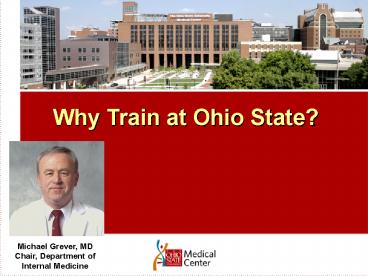Why Train at OSU - PowerPoint PPT Presentation
1 / 27
Title:
Why Train at OSU
Description:
Supplement clinical experiences with didactics and workshops to enhance your education. Built-in time for career exploration and non-clinical professional ... – PowerPoint PPT presentation
Number of Views:39
Avg rating:3.0/5.0
Title: Why Train at OSU
1
Why Train at Ohio State?
Michael Grever, MD Chair, Department of Internal
Medicine
2
Mission
- Prepare Residents to be leaders in the provision
of compassionate, high quality, safe care
throughout their career.
Catherine R. Lucey, MD, FACP Vice Chair of
Education, Dept of Internal Medicine Vice Dean of
Education, OSU College of Medicine
3
How?
- Outstanding Faculty Diverse Patients
- Supportive, bright, valued peers
- Supplement clinical experiences with didactics
and workshops to enhance your education. - Built-in time for career exploration and
non-clinical professional development.
4
We are Successful
19 Heme/Onc 24 Renal 27 Pulmonary 42
Endocrine 5 other OSUMC programs also ranked
30 Research 31 Primary Care
5
We are successful
- 10-year Accreditation Awarded from ACGME EIP
Program (only top 5 of programs received) - 64 of our residents pursue fellowship training
- Comprehensive Internal Medicine (16) and
Hospitalist (15) practice opportunities
6
We are substantial
- Largest Department at the Largest University in
U.S. - 235 faculty attendings
- 60.8 Million total research funding
7
Fellowship Opportunities at OSU
- Allergy/Immunology
- Cardiology
- Cancer Genetics
- Endocrinology
- Gastroenterology
- Geriatrics
- Hematology/Oncology
- Infectious Diseases
- Nephrology
- Palliative Medicine
- Pulm/Critical Care
- Rheumatology
- Sleep Medicine
8
Where Have our Residents Matched for Fellowship
Training?
- Allergy OSU, Mayo Clinic, NIH, Cleveland Clinic
- Cardiology OSU, Vanderbilt, Wisconsin,
Allegheny, Florida - Pulmonary/Critical Care OSU, Colorado,
Vanderbilt, Nebraska - Nephrology OSU, Michigan, UW-Seattle,
Northwestern, Minnesota - GI OSU, Colorado, Vanderbilt, Nebraska, Florida,
UW-Seattle, Kentucky, UCSF, South Carolina - Heme/Onc OSU, Iowa, UW-Seattle, Northwestern,
Johns Hopkins, Minnesota, Duke, Vanderbilt - ID OSU, Utah, Virginia, Indiana, UNC
- Palliative Medicine OSU, Harvard
- Endocrinology OSU
- Rheumatology OSU
9
Program Directorate
David Wininger, MD Program Director
Scott Holliday, MD IM/Pediatrics
Maria Lucarelli MD
Chris Valentine MD
Jennifer Burkhart MD
Michael Langan MD
10
Chief Residents
Deepak Venkat, MD Northwestern GI
Scott Meehan, MD WVU PCC OSU
Anish Amin, MD OSU Cardiology OSU
11
Educational Sites
- Hospitals
- University Hospital
- Ross Heart Hospital
- Arthur James Comprehensive Cancer Center
- University Hospitals East
- Outpatient
- Martha Morehouse Medical Plaza
- Columbus VA
- OSU Primary Care
- Primary and Specialty Office Practices
12
Subspecialty Wards
- Cardiology (ACS, CHF and general)
- Nephrology
- Transplant Medicine
- Hepatology
- Hematology
- Hospital Medicine
- Oncology
- General Medicine
- ID
- Diabetes/Gen Med
- MICU
13
Advantages of Subspecialty Ward Educational System
- Great Teaching from Experts in the Field
- Deeper, more evidence based instruction
- Concentrated Management Experience
- Facilitates the early maturation of your clinical
skills - Progressive Management Autonomy
- Early functioning as the patients PCP
- Career Exposure
14
Unique Features of our program
- Educational Innovations Project
- Career Development Elective
- Optimize your career choices and
- Explore scholarly activities relevant to your
future career - Enrichment Activities
- Teaching Skills Training (Teach you how to teach)
- Medical Education Electives
- Board Review Groups
- Simulation Laboratory Activities
- Practice your skills in a low-stakes environment
15
EIP Selection Process
16
Other Academic EIP Programs
Wisconsin
NEOUCOM
Tufts
Mayo
Beth Israel
UCSF
Indiana
Pittsburgh
U of Cincy
Duke
17
EIP Process Resident-Faculty Design Teams
- Faculty and Resident Collaboration
- All Residents Participate
- Quarterly review of data relevant to each area
- Inpatient, Outpatient, Critical Care
- Development of new strategies for educational and
clinical improvement - EKG curriculum
- Chest X-ray course
- MICU simulator sessions
18
Enhance patient care quality through residency
education 3 strategies
- Focus on Continuous Quality Improvement
- Teach you skills to initiate and lead QI
projects. - Physician Accountability for Competency
Demonstration - Instill in you the commitment and skills to
demonstrate competency - Emphasis on Quality Teamwork
- Provide you with concrete experiences to help you
become a master of effective teamwork - Enhance your ability to plan and manage care
transitions inherent in todays health care
environment
19
EIP Projects
- Procedural Skills Training
- Not just Do one, see one, teach one
- First responder skills
- Fundamentals of Critical Care Course
- Code Blue Debriefing Sessions
- Continuity Practice Blocks
- Practice Improvement Modules
- Clinical Skills Competency with Senior Clinicians
20
Dreyfus Model
EXPERT
PROFICIENT
COMPETENT
ADVANCED BEGINNER
NOVICE
21
Example
22
Sample Schedule
Continuity Blocks are also 50 Ambulatory or
other Electives
C Continuity Block W Ward E Elective
23
Training with Continuity Practice Blocks
- Enhanced patient care and educational experience
- Inpatient rotations no longer interrupted by
clinic - Can focus on the clinic when in the clinic
- Partner practice experience
- Hands on experience in systems improvement
- Improved exposure to ambulatory setting for
primary care and subspecialties
24
Sample Continuity Block Schedule
25
More EIP Goals How you will be part of the
future of residency education
- Defining competency standards for common skills
- Validation of Teaching and Evaluation Tools
- Describe the relationship between educational
interventions and patient outcomes
26
OSUMC Master Space Plan
Rhodes Hall Doan Hall
Ross Heart Hospital
New Cancer Hospital
New Critical Care Tower
27
Biomedical Research Tower

